6 Top Pull-Up Alternatives: Variations, Tips & Tricks
What are the top pull up alternative to test at gym or at home? Check out these exercises and learn how to do each workout properly...
Pull-up alternatives are some of the best moves to increase your overall back strength while working towards a full pull-up. These exercises can be just as challenging and offer a variation of the pull-up suitable for any fitness level..
If you’re struggling to get your first full pull-up and feeling frustrated, pull-up alternatives can be a great tool to add to your workout routine as a pull day workout.
After all, the pull-up is an advanced bodyweight exercise that requires a lot of effort from your lats, shoulders, abdominal muscles and pretty much everything else you can think of.
This full-body move looks simple but is one of the hardest moves to master.
Alternative Exercises & Pull-Ups— Muscles Worked
What exercises target similar muscles to pull-ups?
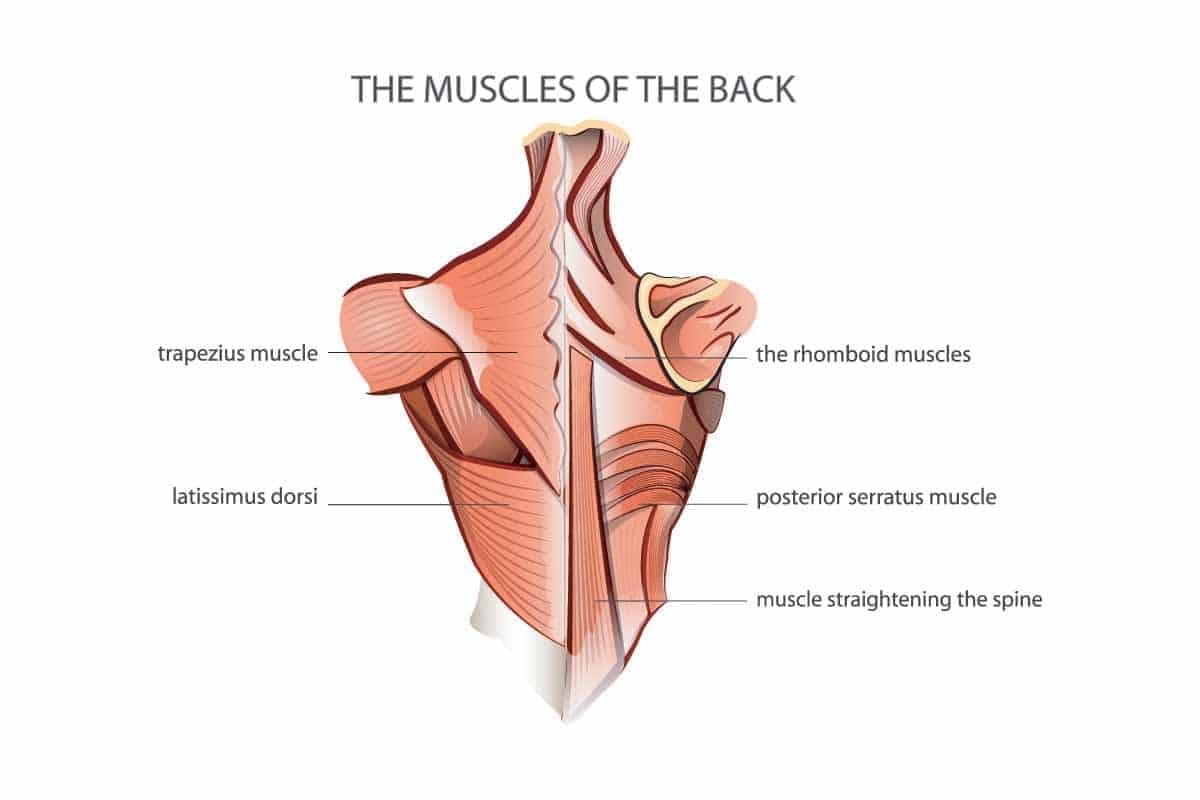
Before we dig into that more deeply, it’s helpful to know which muscles are helping you pull your body up to the high bar.
Pull-ups are primarily a back exercise but recruit many other muscles too. Take a look at the muscles you work in a pull-up.
1. Latissimus Dorsi
Your latissimus dorsi aka “lats” help you stabilize your shoulders and move your arms. These large muscles wrap around your sides and back, helping you climb, throw, and pull your body up.
2. Trapezius
The trapezius muscles, aka “traps” help you to lift, lower, and rotate your scapulae (shoulder blades). These muscles get their name from their trapezoidal shape. They attach to your shoulders and mid back, extending up your neck.
3. Biceps
Your biceps brachii (usually called just “biceps”) are the muscles on the insides of your upper arms. Whether you have prominent bicep veins or bad bicep genetics and arms that could use a little work, these muscles help you flex your elbows.
As you pull your body from the “down” to the “up” position in any pull-up alternative, your biceps will need to create a strong bend in the elbows to help drive your movement.
These are your prime movers. In other words, the main muscles that drive this move.
But pull-ups also work a handful of secondary muscles. Other muscles that are recruited during a pull-up alternative are:
- Abdominal muscles
- Deltoids (shoulders)
- Pectoral muscles (chest)
- Brachialis
- Serratus anterior
- Rhomboids
- Erector spinae
- Forearm muscles
All of these muscles work in tandem to help you lift your full body weight up to a pull-up bar. In a pull-up alternative, you may be using only a few of these muscles depending on whether you are mobile or stationary during your exercises.
Some variations use more back strength like a full pull-up. Other pull-up alternatives like chin-ups for biceps, work more of your arm strength. This typically makes a chin-up variation more accessible than a pull-up.
On that note, let’s see how you can modify your pull-ups to suit your skill level as you progress. We’ll go through a few body position ground rules and look at what equipment needs you may encounter.
Pull-Up Alternatives— Exercise Modifications
Certain variations of pull-ups might be easier or more suitable for your fitness level or physical limitations.
First, let’s start with the two closest progressions you can do to a full pull-up: the chin-up and the band-assisted pull-up.
Take a look at our how-to guides for these exercises.
1. Chin-Ups
- Set-Up: Find a pull-up bar. Make sure you can support your full weight and that you’ve got enough space between your feet and the ground when you’re hanging.
- Body Position: Grab your bar with an underhand grip. Keep your hands shoulder-width apart. Hang down from the bar, fully extending your arms. Focus on engaging your abs to keep your body in a straight line. This will reduce the amount that you swing (swinging makes the work harder).
- Action: Pull your body up toward the bar using your biceps and upper back. Try to get your chin above the bar.
- Reverse: Lower your body back to the starting position in a controlled manner, fully extending your arms.
- Reps: 3-4 sets of 8-12 reps.
2. Assisted Pull-Ups with Resistance Bands
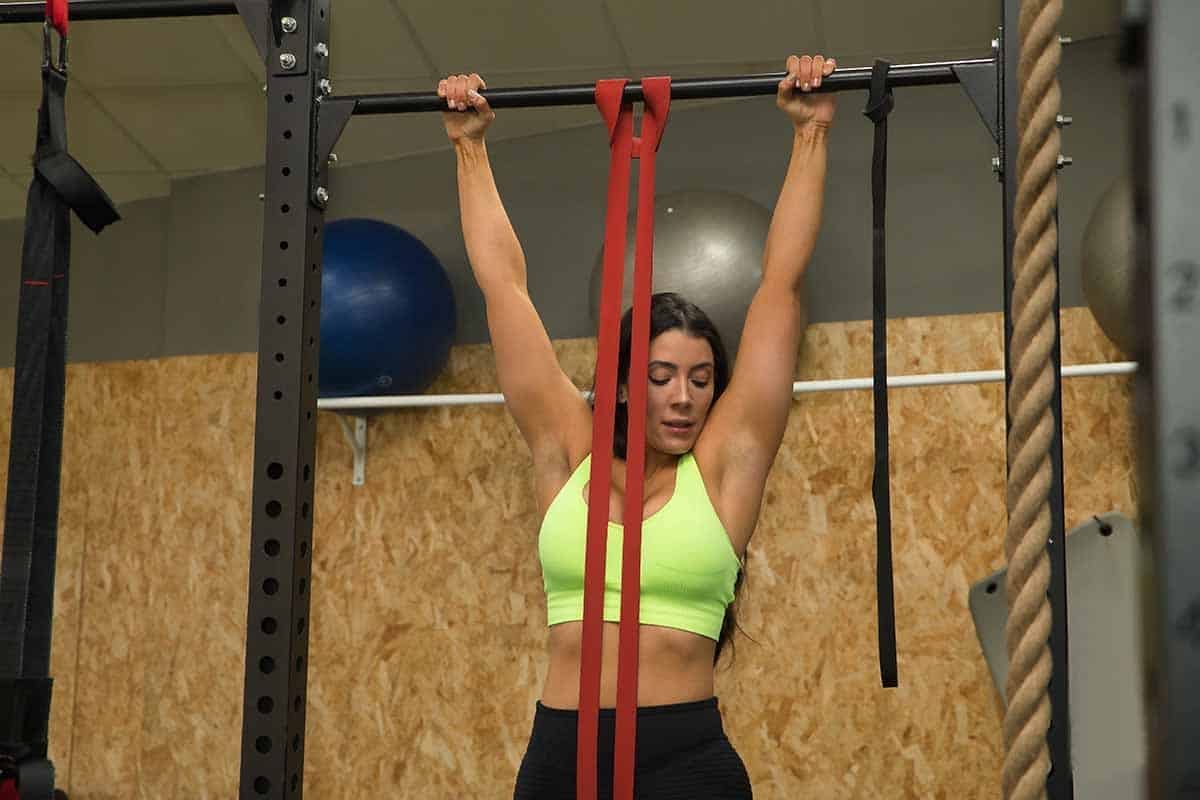
- Set-Up: Loop a resistance band around your pull-up bar. Pop one knee or foot into the bottom loop of your band.
- Body Position: Hold the bar with an overhand grip, keeping your hands shoulder-width apart. Hang with your arms fully extended and your body straight.
- Action: Pull your body up towards the bar, focusing on driving up out of your back and shoulder muscles. Try to get your chin to hover just above the bar.
- Reverse: Hold for a moment, then lower your body back to the starting position with control by slowly extending your arms.
- 3-4 sets of 10 reps.
The next few moves don’t directly mimic pull-up action as closely as a chin-up or assisted pull-up would, but they do work to develop the same muscles.
Here are some moves you can work on regularly that will strengthen the muscles you need for pull-ups.
Pro-Tip: If you’re a novice in the gym, work on moves 3 through 6 BEFORE you jump up to the bar. These moves all work to develop the fundamental strength that you’ll need for pull-ups. Many newbies can’t hold their own body weight up yet.
So if you’re new, start with the bottom half of this list and then simply try a dead hang: Hang with your arms extended and your body straight from a high bar for as long as you can!
Time yourself and see if you can get 3 reps of 45-second to one-minute holds consistently before progressing to chin-ups or band-assisted pull-ups.
3. Lat Pulldown
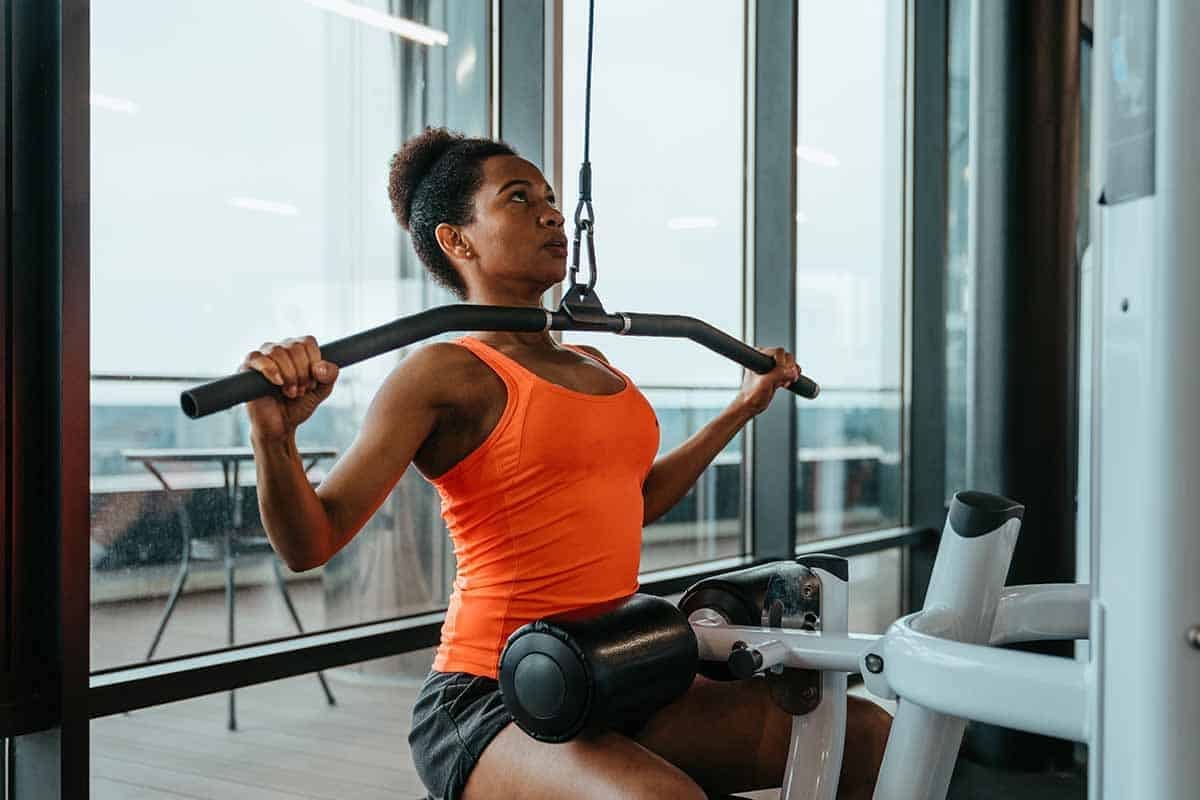
- Set-Up: Sit at a lat pulldown machine with a bar attached to the top pulley. Adjust the knee pads so they fit securely over your thighs. Make sure the machine is set up for your height.
- Body Position: Sit with your feet planted on the ground. Hold the bar of your machine with an overhand grip and lean back slightly keeping your chest proud.
- Action: Pull the bar down towards your chest, focusing on engaging your lat muscles and squeezing your shoulder blades together.
- Reverse: Slowly straighten your arms to return to your starting position, maintaining control.
- Reps: 3-4 sets of 10-12 reps.
4. Bent Over Rows
- Set-Up: Stand with a barbell or a pair of dumbbells in front of you. Keep your feet shoulder-width apart.
- Body Position: Hinge from your hips and bend your knees slightly, keeping your back straight and core engaged. Hold your weight(s) with an overhand grip.
- Action: Pull the weight towards your lower chest/upper abdominal region, squeezing your shoulder blades together once you get to the top of this move.
- Reverse: Hold, then bring the weight back down by straightening your arms.
- Reps: 3-4 sets of 8-12 reps.
5. Inverted Rows
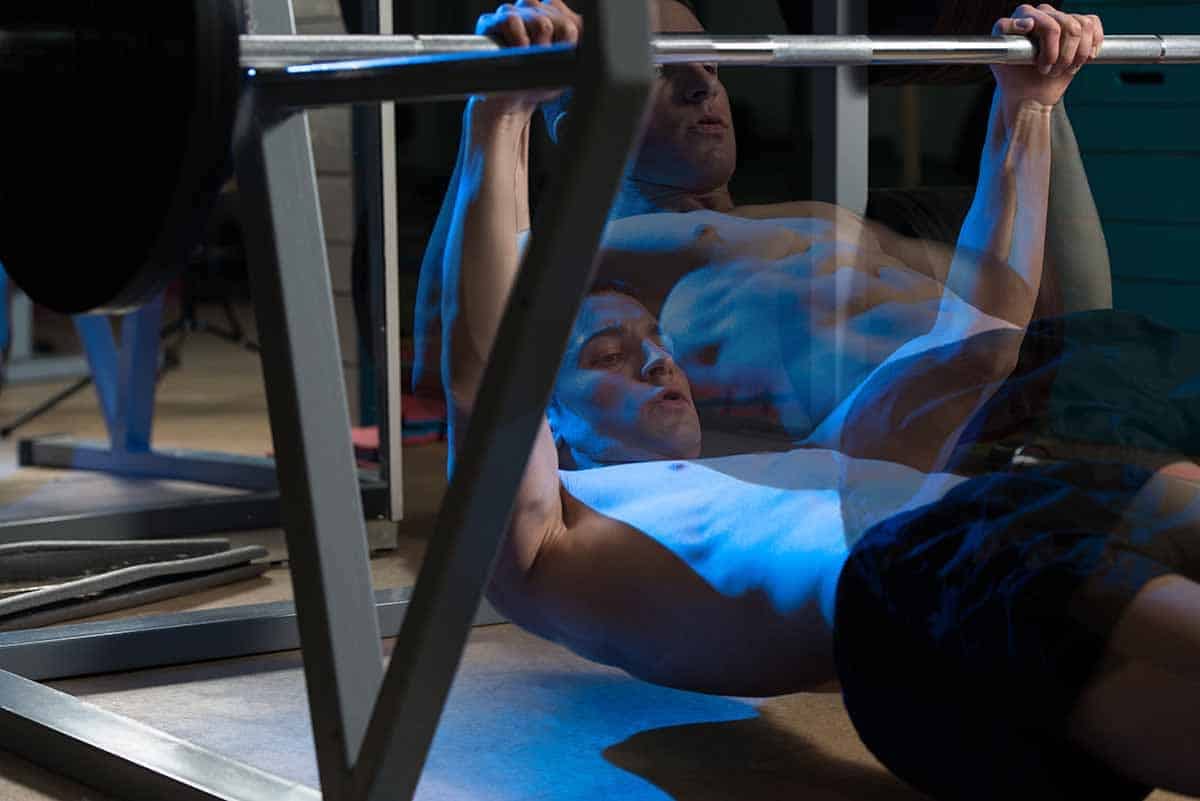
- Set-Up: Set a barbell up in a power rack at waist height. You can also use a Smith machine or TRX straps if you want to train your stability. Lie underneath your bar/chosen piece of equipment.
- Body Position: Hold the bar with an overhand grip keeping your hands a bit wider than shoulder-width apart. Keep your body in a straight line from your head to your heels with your heels on the ground. Your body should be at a diagonal as you row.
- Action: Pull your chest up towards the bar, squeezing your shoulder blades together at the top of the move.
- Reverse: Slowly and with control, lower your body back down, being careful not to let gravity bring you down or dump into your shoulders (this causes injuries!).
- Reps: 3-4 sets of 10-15 reps.
6. Single-Arm Dumbbell Rows
- Set-Up: Put a dumbbell on the floor next to a flat bench. Prop one of your knees and one hand up on the bench for support.
- Body Position: With your back straight and parallel to the ground, grab your dumbbell with the hand opposite your knee on the bench.
- Action: Pull your dumbbell up towards you, focusing on using your back muscles and keeping your elbow in tight to your side.
- Reverse: Bring your dumbbell back down to hang in front of you with control then continue for reps.
- Reps: 3-4 sets of 10-12 reps per arm.
These exercises will hit the same muscle groups as pull-ups. They give you a number of alternative ways to build up your back strength and develop your muscles.
Once you’re confident in these moves, circle back to exercises one and two. You’ll feel far more comfortable understanding muscular engagement and having the strength you need to lift your body up from a “down” position toward your bar.
Equipment Substitutes
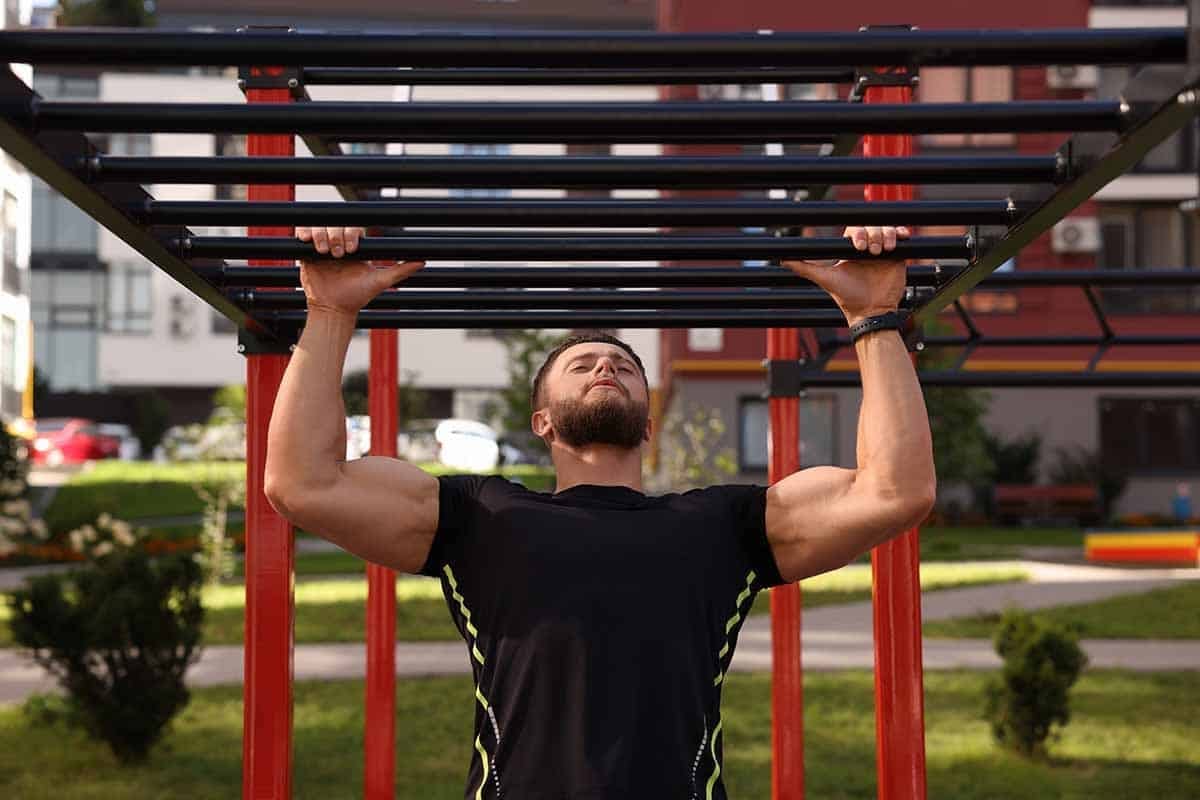
What equipment considerations do you need to make when you’re working on pull-up variations?
As a rule, the moves that directly mimic pull-ups (chin-ups, resistance band pull-ups), will require a high bar and resistance bands (you can use bands if you’re struggling to get a chin-up too).
Some gyms also offer an assisted pull-up machine you can use that loads from a weight stack.
Otherwise, you may want to consider kettlebells as a substitute for dumbbells in your rows if it feels better for you.
The low bar for your inverted rows can be swapped with TRX straps, but they’ll require more stability since straps don’t sit in a fixed position like a bar. If you’re outside, you can also work on some of these moves with monkey bars or an outdoor jungle gym.
Big Picture
Incorporating pull-up alternatives into your workout routine is relatively simple and highly beneficial to getting you on track for full-form pull-ups.
Moves like bent-over rows, inverted rows, and lat pull-downs can help with muscle development and strength in the back, shoulders, and arms. These alternatives give you variety. You won’t be struggling physically and getting bored while you desperately try to kip up into one measly pull-up to no avail.
Instead, you’ll develop the fundamental strength you need first before you ever hop up to the bar.
Start out with activities you can do on a machine or a weight bench, like rows and lat pulldowns. This helps you understand how to engage your back muscles and where your shoulders are sitting to help you move your weight.
Next, work up to bar progressions like chin-ups and band-assisted pull-ups. We recommend these variations for people who already have some base strength in their backs from training and want to get the feel of a pull-up with a bit of extra support.
All these progressions and exercises accommodate different fitness levels, making them accessible to beginners and advanced athletes alike.
You can even improve pull-up performance once you do finally manage to get your first pull-up. Cross-training by targeting similar muscle groups will ultimately lead you to better overall upper body strength and function.
Working your way up gradually also reduces your injury risk, helping you work on your pull-ups with proper form and technique.
Pull your workouts up to the bar. Attack your back with these snippets of further reading:
- Muscle-Up Progression
- Mid Back Exercises
- Cable Back Workouts
The Flex App progresses as you do with plate tracking capabilities and auto progression. Try it out for free today.
References
Jeno, S. H., & Varacallo, M. (2023). Anatomy, Back, Latissimus Dorsi. In StatPearls. StatPearls Publishing.
Vigouroux, L., & Devise, M. (2024). Pull-Up Performance Is Affected Differently by the Muscle Contraction Regimens Practiced during Training among Climbers. Bioengineering (Basel, Switzerland), 11(1), 85. https://doi.org/10.3390/bioengineering11010085
Related articles


Get fit with Flex
Build muscle & lose weight fast for free.
Available on iPhone + Apple Watch





